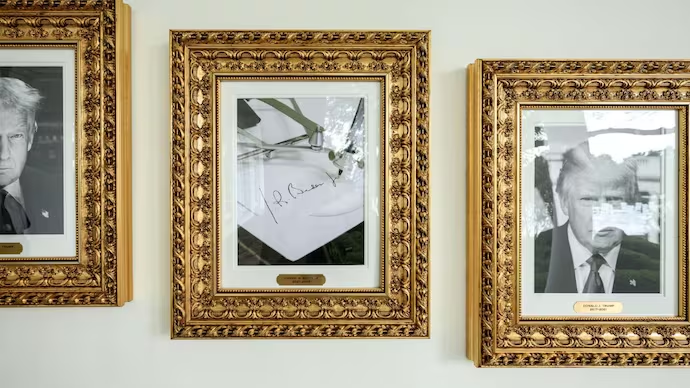President Donald Trump has stirred controversy by unveiling a new “Presidential Walk of Fame” at the White House that includes portraits of past presidents but notably excludes one. In the spot reserved for Joe Biden, Trump instead placed a photo of an autopen signing Biden’s name. Many view that as a deliberate mockery and part of Trump’s broader effort to question Biden’s legitimacy.
What the Walk of Fame Shows
The installation along the West Wing colonnade features framed portraits of presidents in sequence from George Washington through Trump himself. Visitors walking past will see every past commander-in-chief’s face, except for Biden’s. At his frame, they’ll only see the mechanical signature device. Trump’s critics say this sends a clear message that he views Biden as unable or unworthy to be represented fully.
Why the Autopen Move Matters
Trump has long criticized Biden’s use of the autopen, claiming the device lets others sign documents on his behalf and suggesting that key decisions during Biden’s term lacked his direct consent. Because multiple presidents have used autopens for efficiency, critics argue that Trump’s framing lacks historical consistency. Yet by putting only an autopen in Biden’s spot, Trump reinforces his narrative of skepticism and portrays Biden’s presidency as less authentic.
Reactions From Both Sides
Supporters of Trump praised the move as bold and symbolic, a public statement rather than a mere portrait hanging. They say he is drawing attention to what they believe are legitimate questions around governance and accountability. Meanwhile, Biden’s team declined to comment when asked, although many media analysts harshly criticized the gesture as petty, divisive, and beneath presidential decorum.
Symbolism and Political Theater
This incident shows how symbolic acts play a big role in politics. By altering decor, Trump mixes art and message, making the choice of image part of the narrative. The omission transforms a portrait wall from a historical display into a political statement. In effect, Trump uses the visual environment to underscore his critiques rather than just using speeches or tweets.
What Comes Next
We will likely see further discussion and reporting around the use of autopen devices, presidential legacy, and the norms of how presidents represent one another. Congress or historians may weigh in, and public reaction could force adjustments. The portrait is sure to spark debate about respect between administrations, symbolic power, and how politics encroaches on even the design of the White House.
Conclusion
With the new “Walk of Fame,” President Trump opted to snub Joe Biden by replacing his portrait with a photo of an autopen signing his name. That choice echoes prior critiques by Trump and elevates symbolism to political messaging. Whether you see it as provocative or petty, it highlights how, in politics, even portraits can become battlegrounds in perception and legacy.
Bonus Read: Kamala Harris Breaks Silence in 107 Days



